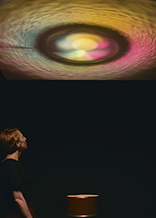
“Lumia: Thomas Wilfred and the Art of Light,” now on view at the Yale University Art Gallery, incorporates materials from the Thomas Wilfred Papers held in Yale University Library’s Manuscripts and Archives. The collection includes Wilfred’s correspondence, drawings, photographs, and miscellaneous materials documenting his professional career.
Thomas Wilfred (1889-1968), a Danish-born American artist, musician, and inventor, chose light as his preferred artistic medium. Formerly a successful lute player, Wilfred channeled his musical talents into his artistic endeavors by creating performative, time-based works. He called these creations of light and color “lumia.” Very few of his works are static, and many unfold over a set length of time. Untitled, Op. 161, currently on view at the Yale University Art Gallery, runs for one year, three-hundred and fifteen days, and twelve hours before repeating itself.
After moving to the United States in 1916, Wilfred began developing the Clavilux, an organ-like mechanical invention that allow others to create, manipulate, and project lumia in real time. Small models, some automatic, were intended for home use. Other versions were quite large. The 1934 Chicago World’s Fair included a Lumia Theatre, where a “lumianist” performed nightly recitals on a large, five-projector Clavilux instrument. Although none of these larger instruments have survived, the Thomas Wilfred papers include photographs and sketches of Clavilux models and projectors, as well as research for design plans and notated compositions for “visual symphonies.”
Musical parallels accompany many of Wilfred’s works. He invented instruments intended for performance, organized formal recitals, created a system of notation, and even referred to his compositions with opus numbers (a system typically used to catalogue a composer’s musical works). Despite these obvious connections, performances of lumia are always silent. Wilfred believed that light could stand alone as its own art form, and he sought to establish this by founding the Art Institute of Light. The Thomas Wilfred papers include sketches for a permanent facility with recital halls dedicated to lumia performances.
With a current exhibit at the Yale University Art Gallery and an upcoming exhibit at the Smithsonian American Art Museum, Wilfred’s lumia are experiencing a revival. The Thomas Wilfred Papers will continue to illuminate the history, technology, and context of lumia for contemporary audiences.
Hilary Purrington